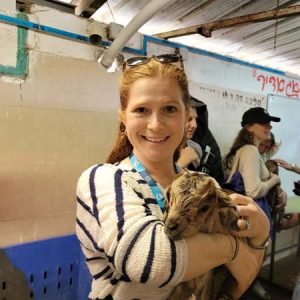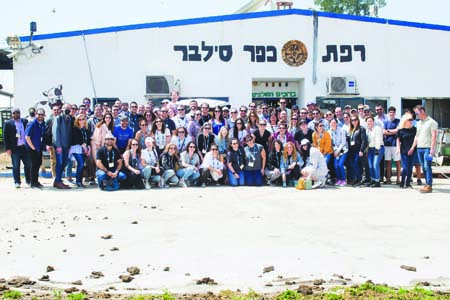By Robyn Galpern

I was able to join 100 fellow ‘young’ leaders to Israel for our first international mission in three years on March 28-April 2.
The impression of this experience is that, in my world, there is a feeling of pause that has engulfed the last two years, the Federation was not part of that pause.
There is just too much work to do. Jews still needed help, more and different help than in the past. Josh Goldberg and I were able to experience this work firsthand. Each day of mission was filled with a choreography of speakers, experiences, memories, connections, and locations to enrich our understand of the work of JAFI (Jewish Agency for Israel, JDC (Joint distribution Committee), and ORT (school and education).
The Group who we traveled with is called the Jewish Federations of North America’s Young Leadership Cabinet, a group of initiative-taking and motivated Jews who are looking for leadership training and opportunities. Cabinet’s goals are to help us prepare for the present and future needs of Jews locally, nationally and internationally. This is an opportunity to experience of what Federation is funding, supporting, and cultivating.
Having only been on one other mission to Russia and Republic of Georgia three years ago, I had an idea of the areas that we would spend our time. Each place we encounter leaves the impression that I am grateful that this place, in present time, exists to assist those that it has reached.
I had the opportunity to discuss with a fellow cabinet member (chevre) his experience recently returning from the Polish border. He discussed the lost and absent look in the eyes of the mother and child he spoke to. He discussed that the day he went to the boarder was a ‘slow day’ when only hundreds needed to find shelter. Crossing the border may have been the end of the evacuation but the start of the next chapter of survival.
He saw how the JDC was mobilized to the borders. With this story fresh in my mind, I spoke to a Russian woman who had made Aliya over 12 years ago from Russia. She was one of a team of 3 JDC professionals who went to the Romanian boarder 6 days after the start of the war.
She discussed how it took them a matter of days to increase from 150 refugees to over 1,000 needing to mobilize supplies, ensure shelter, start paperwork for making Aliya, and planning safe passage after all their human needs were met with food, medicine, phone calls and such. They increased the staff to 15 to accommodate and just continued moving forward.
She discussed the challenge of having a Russian accent and knowing this will increase the anxiety of those who she is trying to aid. The goal was the same, but the journeys were vastly different for the Ethiopians who we met on our first day.
The Ethiopian Olim (those who made Aliya) travel to an absorption center for 2-3 years. The apartment building turned JAFI center was decorated with Ethiopian art, and structures including a garden.
We partook in a coffee ritual that is the center of community life in Ethiopia. The goal of these programs throughout Bear Sheva and other areas is to honor the Ethiopian culture and layer the needed education on top to allow success in the Israeli economy and culture.
There are thousands of Ethiopians who are waiting for permission to make Aliya. There is a large difference culturally, educationally and sometimes religiously in the people who were able to make Aliya in 1984/1991 and the Ethiopians who are entering now. Our goal in meeting them, is not to peer into the people’s lives; our goal is to learn the human aspect that the Federation is supporting.
When I asked the elderly gentleman who had recently moved into the absorption center if this situation was what was promised or expected, he replied: “This is what the Torah told me to expect from my fellow Jews.” He was so grateful. After our authentic lunch, we discussed the issue of race, difficulty in upward mobility and the learned idleness within some of the community. These continue to be an active struggle yet those who we met are having the hard conversations, are building each other up and are working toward a more equitable and self-sustaining future.
The next morning, we were introduced to members of the LGBTQ+ community who are supporting Israelis and Arabs in connecting with safe and welcoming resources. Later that day, we met with members of the Haredi community who, through a program with JDC, provide resources and employable skills training to better their families.
More than 50% of Haredi families live below the poverty line. This program is provided with the respect and nuance that is required to engage this unique community.
We ended in Jaffa at the Peres Center for peace and innovation, a museum of such to teach the marvels that Israel provides to the world in medical, technological, and next start of nation phenomena. I could write a whole article just on this Center.
President Isaac Herzog spoke to us about his sincere desire to work for a more peaceful future with Israel’s neighbors. He encouraged continued leadership around the delegitimization of Israel, especially in the U.S. and praised JFNA’s Ukraine relief efforts.
He told us about the positive non-partisan movement toward peace and continued hope for the near future. This was unfortunately also the deadliest week since 2006. He spoke about there still being so much work to do. That work is much easier with our support.
My final day on mission we started with another amazing Israeli breakfast. Our speakers were creators of another connection opportunity. Israel is so good at seeing a need and filling it. We heard from Israelis (Jewish and non-Jewish) who designed a person focused, communication-based experience through Israel-is. This in an NGO (one of many) and connection opportunity to safely and non-judgmentally support the Abraham Accords.
Then we traveled to a one-of-a-kind ORT School called K’far Silver. This school is miles from the Gaza border, focused on identifying student passions and using that passion to drive a love of learning and an opportunity to develop skills. This educational model is focusing on both STEAM education as well as agriculture.
It can support learners who may not thrive in a classroom-only environment. The middle school and high school children are taught hand-on life skills. Besides the challenges of being a boarding school with technology, farming, and goats/cows to raise, they have accepted 20+ Ukrainian children (in the last 2 weeks) who are receiving the counseling, support, and education that they require to survive and thrive in this new reality.
I have been fortunate to go to Israel many times in my life. Each time I go, I learn a bit more about the Jewish heart, the unwavering need for Israel to exist and the depth of commitment to making any/everything better.
While this was a rich and varied itinerary, it reflects the high regard that JFNA holds, and what really stands out about these experiences is the range of beneficiaries that Federations touch. From supporting Jews all over the world – from Ethiopia to Ukraine to Russia and Israel, and then back again to issues in the U.S. – we are instrumental in supporting the Jewish community globally.
The fact that Federation has the infrastructure to continue moving forward with the Ethiopian Olim while simultaneously (within days) mobilize to support the needs of the Ukrainian Jews is incredibly hard to fathom. Yet here we are, and Federation continues to act on these massive tasks. The Missions that Cabinet takes allow Chevre to see in person the many organizations and people globally that benefit from the actions that we take at home. This in turn galvanizes me and my Chevre to continue making that necessary impact.











